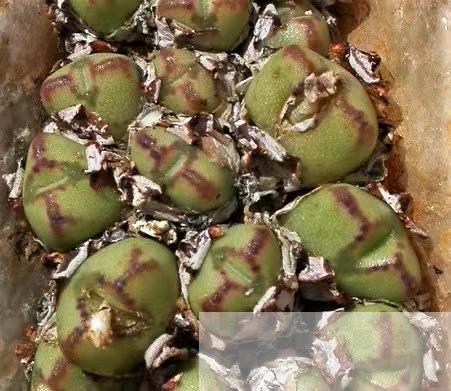编者按:肉锥清网行动注意到,安迪·杨教授的一篇文章《绿色钻石》颇有启示。安迪·杨(Andrew&j9九游会九游国际版nbsp;J. Young)是著名英国学者,是英国利物浦约翰摩尔斯大学的一名研究员,专注于自然科学和心理学等多个学科领域。他拥有学士和博士学位。近年来,他以肉锥研究而闻名。
在植物学和肉锥(Conophytum)方面的研究涉及到许多学科,包括遗传学、古生物学、生态学和分类学。他在植物学方面的研究主要涉及到植物的基因组大小和变异,以及不同物种之间的遗传差异。在肉锥(Conophytum)方面的研究中,他关注的是该物种的分类和演化,以及它在干旱和气候变化等生态系统中的角色。他的研究还探讨了肉锥(Conophytum)的花器官的结构和功能,以及肉锥植物的细胞壁成分和细胞外基质。此外,他还研究了肉锥植物的次生代谢产物,如卡罗莱因,以及这些化合物在植物生长和发育中的作用。他的研究还探讨了肉锥植物的光合作用和色素合成,以及这些过程在植物适应环境变化方面的作用。经专家本人同意,现将他的《绿色钻石》一文翻译分享如下。

上图:肉锥安东尼 Conophytum antonii 。摄影:Chris
《绿色钻石》
作者:Andrew J.Young
翻译:独眼鹰
在南非,我听到过一个用来形容矮多肉植物的术语是“绿色钻石”。这源于这样一个事实,即一些当地人认为,与非法挖掘钻石相比,收获肉锥(Conophytum)等植物既容易又安全。
非法采伐多肉植物的规模之大真的令人恐惧。自2019年以来,南非偷猎者没收了近40万株肉锥(Conophytum)植物,并在克斯腾伯斯国家植物园(Kirstenbosch)和其他植物园进行照料。假设没收的植物最多占从栖息地非法移走的所有植物的10%,我们可以估计,仅在过去三年中,就至少收集了400万株肉锥(Conophytum)植物(其中绝大多数在2020-21年)。这个数字几乎可以肯定是被低估了。这些收获的植物中有许多可能没有存活下来。偷猎还影响了地理上的花卉多样性,因为偷猎似乎主要集中在纳马夸兰(Namaqualand)中部和理查德斯维德(Richtersveld)的部分地区。虽然大多数偷猎似乎发生在“开阔地”,但农场或自然保护区的植物并不能起到威慑作用。
到目前为止,肉锥花属(Conophytum)在偷猎流行病中首当其冲,但随着市场开始饱和,其他多肉的属(如厚敦菊属Othonna、奇峰木属Tylecodon和许多球茎)越来越多地成为目标。
下一个将是哪些属和物种?毫无疑问,社交媒体上的图片分享导致了“网红”物种的趋势,这种趋势往往是短暂的,社交媒体加剧了这个问题,极大地推高了世界某些地区对这些“网红”植物的需求。
世界自然保护联盟(IUCN)濒危物种红色名录目前正在更新,以正确反映偷猎流行病的影响。这一过程还评估了其他活动(尤其是采矿)和未来气候变化对单个分类群的影响。尽管最终评估仍在等待正式批准,但大多数肉锥(Conophytum)植物现在可能会被列为“要么极度濒危,要么濒临灭绝,其余被视为易危或近危。这项工作将确定关键的保护重点,并通过强调那些真正有风险的分类群来帮助南非当局,以便罪犯有望受到相应的惩罚。
我们能做什么?许多肉锥(Conophytum)分类群现在面临着在野外灭绝的真正风险。的确目前,几种肉锥(Conophytum)植物可能已经灭绝,或者仅以少数几株植物为代表(以及栖息地土壤中的任何残留种子,主要是由于偷猎。现在,像金币(C.bachelorum)这样的物种在种植中的数量比栖息地中的数量多。因此,作为个体,我们应该认为我们的藏品是一种宝贵的生物资源,需要适当的保护,在许多情况下有助于保护特定的物种,英国仙人掌与多肉协会正在提供一些资金,以帮助南非“前线”的人们维护被没收的植物,并协助(在适当的情况下)建立迁地收藏(许多被没收植物缺乏来源往往是一个问题)。MSG年度种子清单是建立和维护迁地收藏的宝贵材料来源(补充了用野外收集的种子建立的植物园中的正式收藏)。
从种子中生长也是最有价值的,因为它反映了一个物种内的变异性,许多植物在年轻时看起来更好(例如,C.pellucidum衰老后会变得丑陋!最重要的是,这种种子清单是从真正可靠/合法的材料来源获得的。我们也可以分享材料,无论是备用的幼苗还是插条(绝大多数Conos的身体在秋季很容易重新生根)。
如果你没有为你收藏的肉锥植物尝试授粉来生产你自己的种子,那么我鼓励你尝试一下。这并不难,因为你只需要一根“挠痒的棉签”和一些记录你授粉尝试的方法。我要么用一根从家用画笔上取下的尼龙毛(正如史蒂文·哈默多年前向我展示的那样,它可以在拇指和食指之间旋转,产生直升机般的运动,可以非常有效地拾取花粉)或者一把便宜又愉快的细尖画笔(从亚马逊购买)。我用彩色标签标明哪些植物是人工授粉的,这样我就可以丢弃没有标记的花盆里的种子胶囊。当为夜间开花的肉锥植物授粉时,手电筒可能很有用。应该尽一切努力阻止昆虫(这几乎是不可能的任务)。为了确保授粉成功,需要在几天内(最好是在一天中的不同时间)进行几次授粉的尝试。成熟的种囊会在第二年随着植物老皮的脱落而收获。
GREEN DIAMONDS
by Andrew J. Young
One of the terms I have heard used to describe dwarf succulents in South Africa is Green Diamonds . This derives from the fact that some locals believe that it is both substantially easier and safer to harvest plants such as Conophytum than conduct illicit digging for diamonds.
The sheer scale of illegal harvesting of succulents is truly frightening.Since 2019 almost 400,000 individual Conophytum plants have been confiscated from poachers in South Africa and are being looked after at Kirstenbosch and other botanical gardens. It is not unreasonable to assume that confiscations represent at the very most 10% of all the plants illegally removed from habitat then we can estimate that at least 4 million Conophytum plants have been collected in the last three years alone (the vast majority of these in 2020-21). This figure is almost certainly an underestimate. Many of these harvested plants have probably not survived. The poaching also impacts floral diversity geographically in that the poaching appears to be primarily centred around parts of central Namaqualand and the Richtersveld. While most poaching seemingly takes place on open lands the presence of plants on farms or nature reserves is no deterrent.
To date, the genus Conophytum has borne the brunt of the poaching epidemic but other succulent genera (e.g., Othonna, Tylecodon and numerous bulbs) are increasingly being targeted as the markets start to saturate with Conophytum.
Which genera and species will be next? There is no doubt that the sharing of images on social media leading to,often short-lived,trends of ’must-have’ species has compounded the issue, significantly driving up demand in certain parts of the world.
The IUCN Red List of Threatened Species is currently being updated for the genus Conophytum to properly reflect the impact of the poaching epidemic.This process also assesses the impact of other activities (notably mining) and future climate change on individual taxa.Although the final assessments await formal ratification it is likely that the majority of Conophytums will now be listed as either Critically Endangered or Endangered, with the remainder regarded as Vulnerable or Near Threatened. This exercise will identify key conservation priorities as well as aiding the authorities in South Africa by highlighting those taxa that are at real risk so that culprits will hopefully be punished accordingly.
What can we do? Many Conophytums taxa are now at real risk of extinction in the wild. Indeed, several Conophytums taxa are now probably either extinct or represented by only a handful of plants (and any residual seed in the soil in habitat, primarily due to poaching.There are now more individuals of species such as C.bachelorum in cultivation than are present in habitat. As individuals we should therefore view our collections are a valuable biological resource that needs due care, in many cases helping to preserve particular species. Organisations such as the Mesemb Study Group and the British Cactus Succulent Society are providing some funds to assist those on the front line”in South Africa with the maintenance of confiscated plants, aiding the establishment (where appropriate) of ex situ collections (the lack of provenance for many confiscated plants is often a problem).The annual MSG seed list is an invaluable source of material for establishing and maintaining ex situ collections (complementing formal collections in botanical gardens established with field-collected seed).Growing from seed is also the most rewarding in terms of reflecting the variability within a species and many plants are better looking when young (e.g.,C.pellucidum can get ugly when old!. Most importantly this seed list is obtained from genuine and reliable sources of material. We can also share material,whether spare seedlings or cuttings (bodies of the vast majority of Conos are readily re-rooted in the autumn months).
If you have not tried pollinating Conos in your collection to produce your own seed then I would encourage you to give it a go. It s not that difficult as all you need is a tickling stick and some way of recording your pollinating attempts. I use either a single nylon hair taken from a household paint brush (which, as Steven Hammer demonstrated to me many years ago can be rotated between thumb and forefinger to create helicopter-like motion that can be very effective in picking up pollen) or a cheap and cheerful fine-tipped paint brush (bought en masse from Amazon). i use coloured labels to indicate which plants have been pollinated by hand, allowing me to discard any seed capsules from unmarked pots. A head torch can be useful when pollinating nocturnal flowering Conos. Every effort should be made to keep insects at bay (a near-impossible task!) and avoid cross-fertilisation with other taxa.Several tickling attempts over a few days (ideally at different times of the day) are needed to ensure pollination is successful.Ripe seed capsules can be harvested as the plants desheath in the following year.
文/安迪·杨 翻译/独眼鹰 编者按/Wendy 责编/angel